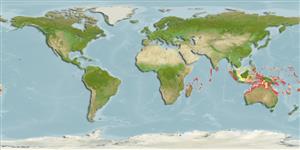>
Ovalentaria/misc (Various families in series Ovalentaria) >
Pomacentridae (Damselfishes) > Pomacentrinae
Etymology: Pomacentrus: Greek, poma, -atos = cover, operculum + Greek, kentron = sting (Ref. 45335).
More on author: Tanaka.
Environment: milieu / climate zone / depth range / distribution range
Ekologi
marina revassocierade; havsvandrande (Ref. 51243); djupintervall 3 - 35 m (Ref. 1602). Tropical; 10°N - 25°S
Indo-West Pacific: Maldives (Ref. 30829) and Sri Lanka to Vanuatu, north to southern Japan; south to northwestern Australia and New Caledonia.
Size / Vikt / Age
Maturity: Lm ? range ? - ? cm
Max length : 11.0 cm TL hane/ej könsbestämd; (Ref. 90102)
Short description
Bestämningsnycklar | Morfologi | Morfometri
Taggstrålar i ryggfenan (totalt) : 13; Mjukstrålar i ryggfenan (totalt) : 15 - 16; Taggstrålar i analfenan: 2; Mjukstrålar i analfenan: 15 - 16.
Adults are found in sandy areas of both lagoon and seaward reefs. They occur in small groups with outcrops of soft coral patches or gorgonians, usually in depths over 20 m (Ref. 48636). Feed primarily on zooplankton. Oviparous, males guard the nest (Ref. 59303). Eggs are demersal and adhere to the substrate (Ref. 205). Diurnal species (Ref. 54980; 113699).
Life cycle and mating behavior
Maturities | Reproduktion | Spawnings | Egg(s) | Fecundities | Larver
Courtship behavior during breeding includes signal jumps, enticement, chasing and skimming (Ref. 59303).
Allen, G.R., 1991. Damselfishes of the world. Mergus Publishers, Melle, Germany. 271 p. (Ref. 7247)
IUCN Red List Status (Ref. 130435)
Threat to humans
Harmless
Human uses
Fiskeri: kommersiell; Akvarium: Kommersiell
Verktyg
Special reports
Download XML
Internet-källor
Estimates based on models
Preferred temperature (Ref.
123201): 24.7 - 28.9, mean 27.6 °C (based on 388 cells).
Phylogenetic diversity index (Ref.
82804): PD
50 = 0.5000 [Uniqueness, from 0.5 = low to 2.0 = high].
Bayesian length-weight: a=0.01479 (0.00642 - 0.03409), b=3.00 (2.80 - 3.20), in cm total length, based on LWR estimates for this (Sub)family-body shape (Ref.
93245).
Trofisk nivå (Ref.
69278): 2.7 ±0.31 se; based on food items.
Resiliens (Ref.
120179): Hög, lägsta populationsfördubblingstid mindre än 15 månader (Preliminary K or Fecundity.).
Fishing Vulnerability (Ref.
59153): Low vulnerability (10 of 100).
Nutrients (Ref.
124155): Calcium = 113 [64, 180] mg/100g; Iron = 0.814 [0.521, 1.255] mg/100g; Protein = 18.6 [17.5, 19.5] %; Omega3 = 0.152 [0.098, 0.230] g/100g; Selenium = 23.9 [14.4, 41.7] μg/100g; VitaminA = 131 [46, 371] μg/100g; Zinc = 2.07 [1.46, 2.82] mg/100g (wet weight);
